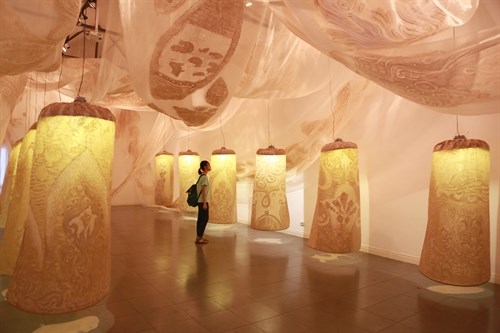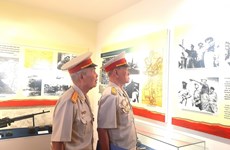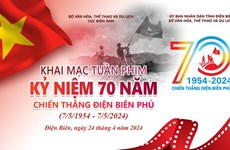River tells stories on bamboo pulp paper
Familiar images of the countryside of Vietnam and of people’s daily activities appear on truc chi (bamboo pulp paper) when it is illuminated by led lights.
 The exhibition of truc chi (bamboo pulp paper) is on going at the Hanoi Goethe Institute (Photo: VNA)
The exhibition of truc chi (bamboo pulp paper) is on going at the Hanoi Goethe Institute (Photo: VNA)Hanoi (VNA) – Familiar images of the countryside of Vietnam and of people’s daily activities appear on truc chi (bamboo pulp paper) when it is illuminated by led lights.
Graphics artworks on bamboo pulp paper are being introduced for the first time in Hanoi at artist Phan Hai Bang’s exhibition Truc Chi - Listen to the River.
The exhibition features 10 artworks called "Raincoats"- and a 100m-long river created by truc chi paintings, in which ordinary stories in the lives of Vietnamese people are told. The works are combined with light, music and video installations.
The exhibition name was inspired by a quote from Heraclitus: “No man ever steps in the same river twice, for it’s not the same river and he’s not the same man."
“Life and creation are ceaseless motions,” said Bang. “Bamboo plants are born and grow by rivers. They die and are revived into a new form, truc chi paper.”
Originally, truc chi was a kind of paper made from bamboo pulp. Based on the traditional process of making the paper, Bang created a new type of art - Trucchigraphy - in which artists create paintings on truc chi paper.
The production of bamboo paper has a long tradition in some Asian countries, but the process is usually completed with the moulding of the paper. This is just the beginning for Trucchigraphy. Artists interact with the wet structure of the paper on the frame and use water pressure and other graphic techniques to change the surface. In this way, unique images are created, which some artists further process through brush or collage techniques.
“Bamboo is a cultural symbol in Vietnamese people’s minds,” said Bang. “It has a strong connection to the spiritual life of the people, sometimes it symbolizes Vietnamese people.”
“I use bamboo for my project because I want to develop this new art form on the basis of traditional values.”
Speaking at the exhibition, painter Nguyen Thanh Son said he was attracted by Bang’s interesting narration.
“He uses the metaphor of the river to depict people’s memory, childhood, life, and the flow of the era and the creation,” said Son. “Through the stories told on truc chi paper, we realize ourselves and our nation. We respect the tradition and learn to respect the traditional cultural values expressed in contemporary creations.”
Bang developed this new form of art and collaborated with art students and painters to found Vietnamese truc chi art in 2012.
Bang studied graphic arts in Hue and at the University of Industrial Fine Arts. He completed his Master’s degree in fine arts at Maha Sarakham University, Thailand. He has taught at the Hue Arts Academy since 1996. His artworks have been presented in numerous group and solo exhibitions.
The exhibition will run until July 15 at the Goethe Institute in Hanoi. Then it will be moved to the Hue Museum of Royal Antiquities.-VNA










